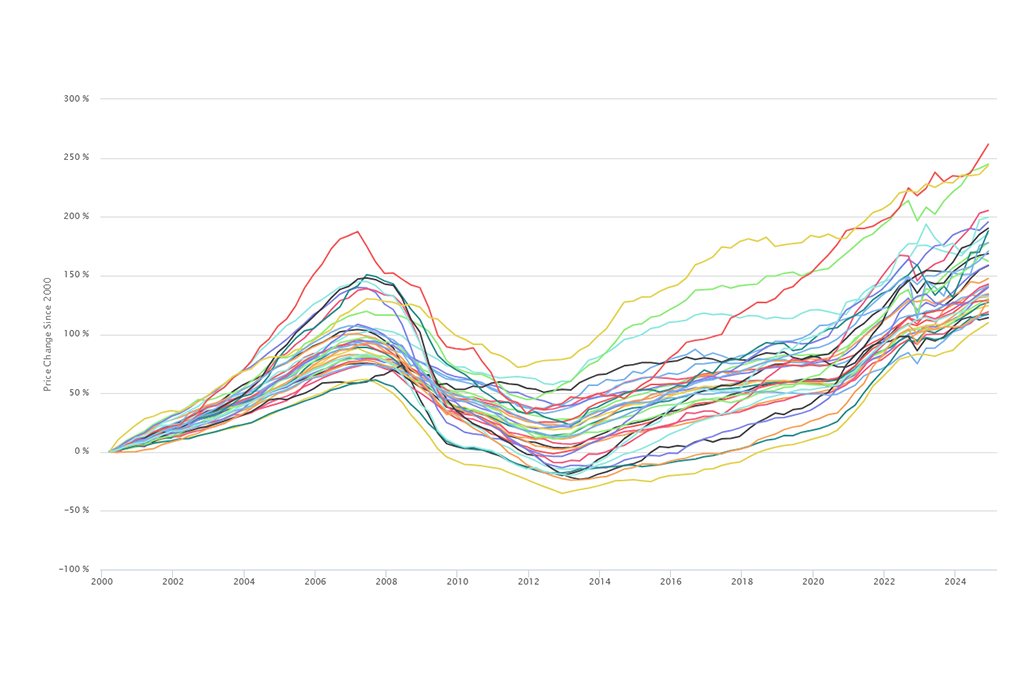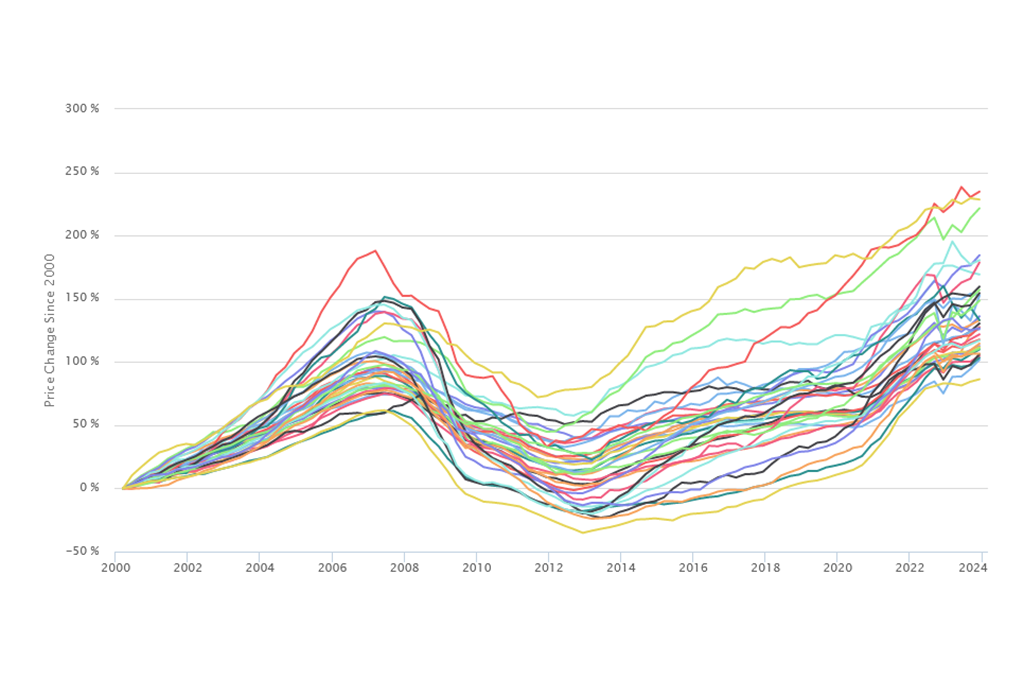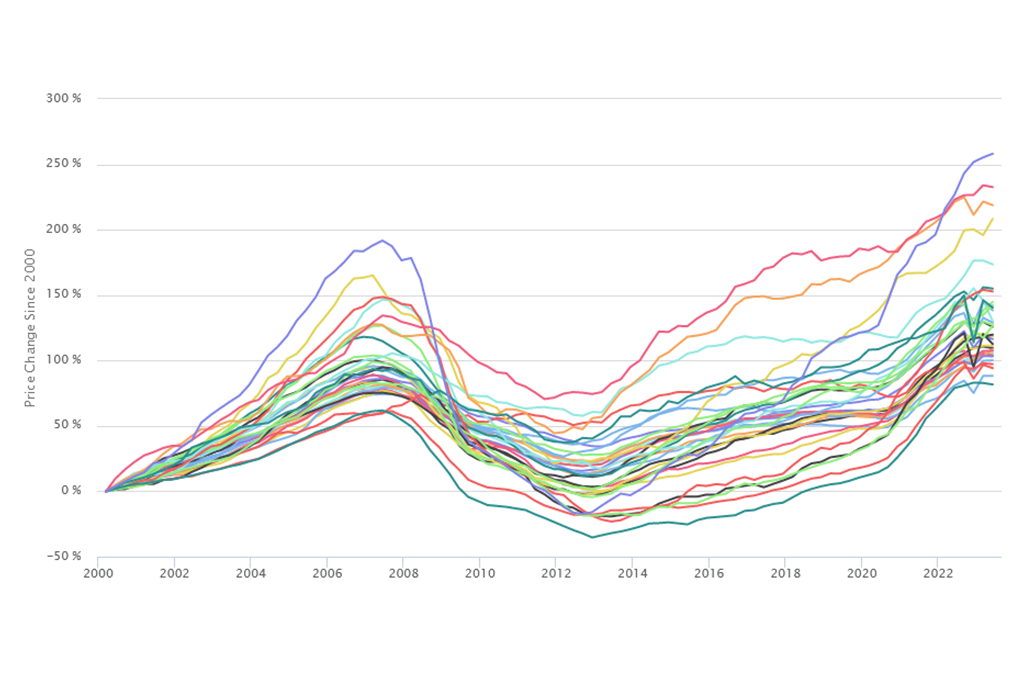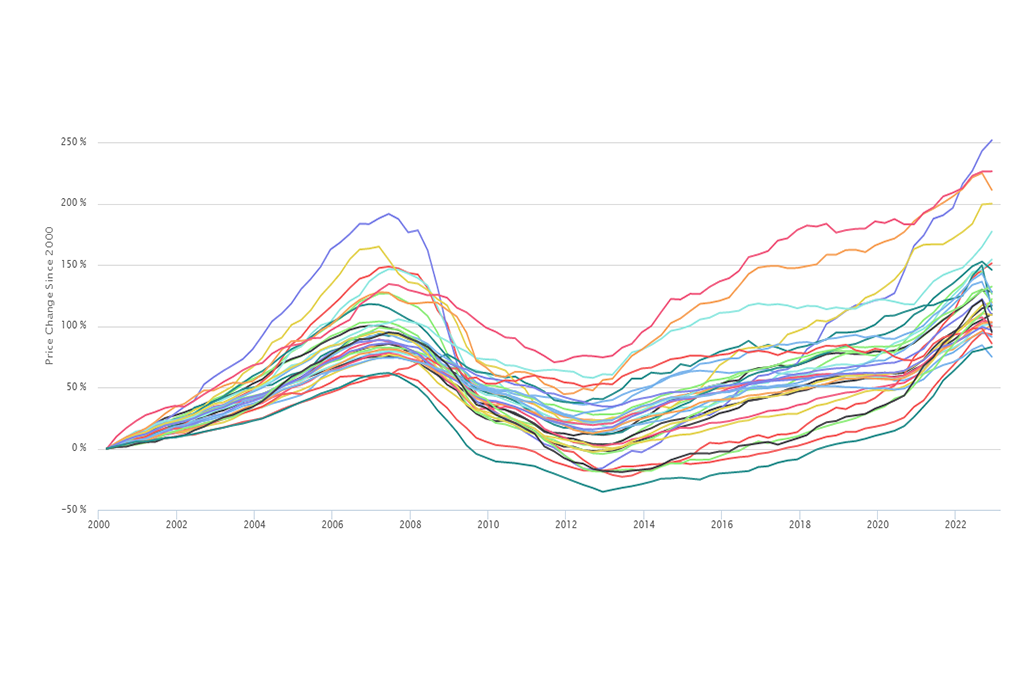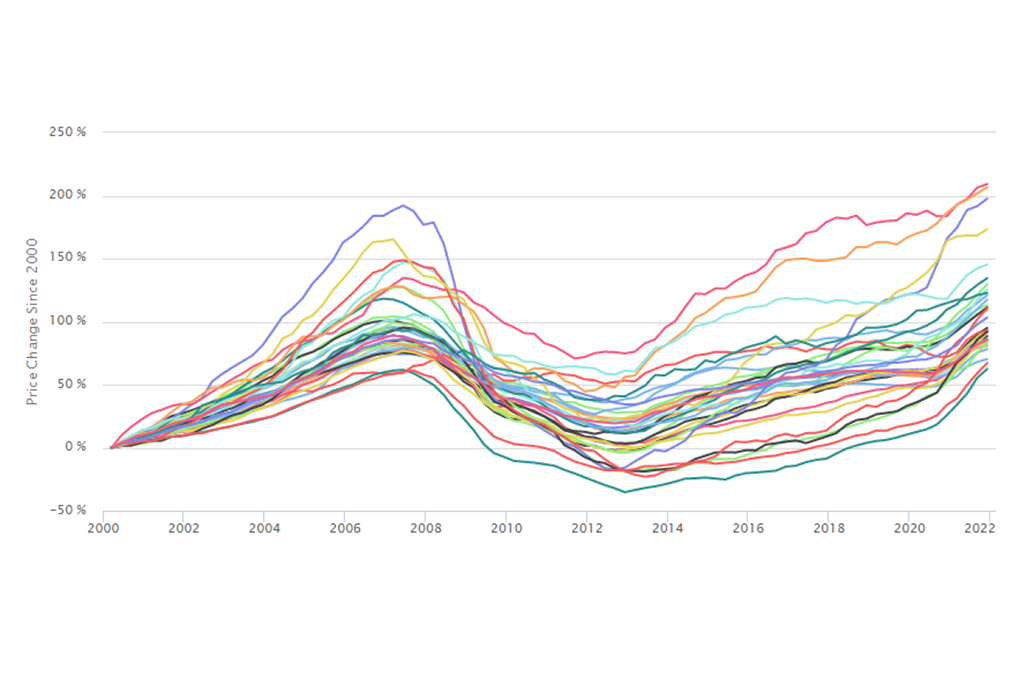This update of the Institute for Housing Studies (IHS) Cook County House Price Index highlights changing prices for single-family homes through the second quarter of 2022 in 16 City of Chicago submarkets and 17 submarkets primarily in suburban Cook County. A detailed discussion of the Index is below. To view a full-page interactive graph with a map and data for all submarkets go here. Underlying price index data can be found here.
This analysis explores trends in house prices as of the second quarter 2022 compared to recent trends and key historical benchmarks. It illustrates the continued strength of the COVID-19 housing market and the variation in house price gains across the county during a period of low mortgage interest rates. New in this Index release, the 2022 second quarter Cook County House Price Index also includes a metric of submarket-level house price changes since the beginning of the COVID-19 pandemic or roughly the first quarter 2020.
While the level of price growth among City of Chicago and Suburban Cook County submarkets varies, this Index update shows that the pandemic housing market accelerated what had previously been incremental gains in house prices since the Great Recession. Whereas nearly 70 percent of submarkets had exceeded price peaks as of the fourth quarter 2021, all but two submarkets have now recovered to pre-recession peak levels as of the second quarter 2022. Given that demand for housing is expected to slow amid rising interest rates, Index data from the second quarter 2022 may be an important benchmark to assess the impact of rate increases on future house price growth.
KEY FINDINGS
Year-over-year price changes
- Areas with the largest increases in single-family sales prices between the second quarters of 2021 and 2022 include Chicago submarkets Englewood/Greater Grand Crossing (26.3 percent increase) and Auburn Gresham/Chatham (23.7 percent). In suburban Cook County, the largest annual increases were seen in south suburban Calumet City/Harvey (24.9 percent increase) and Chicago Heights/Park Forest (24.6 percent increase).
- Since the second quarter 2021 IHS price index update, no submarkets have experienced year-over-year declines.
- On average, house prices in Cook County increased by 14.7 percent compared to the previous year. In the City of Chicago, price levels increased by 14.8 percent, and in suburban Cook County prices increased by 14.9 percent.
Peak to current
- All but two submarkets are seeing single-family house prices above pre-Great Recession levels, bringing the County total to 31 submarkets – a trend that illustrates the strong price growth observed in the real estate market during the pandemic period but also highlights the slow recovery and legacy of the Great Recession in many parts Cook County. By comparison, a year ago in the second quarter of 2021, 12 of 33 submarkets were above their bubble-era peak. Conversely, in the second quarters of 2019 and 2020, just six submarkets had exceeded their previous peak levels. During the last update in the fourth quarter 2021, 23 of 33 had surpassed this recovery benchmark.
- Englewood/Greater Grand Crossing and Bronzeville/Hyde Park are the only two submarkets where single-family prices are below their bubble-era peak – although prices are approaching peak levels. Price levels in the second quarter of 2022 were 3.4 percent lower than bubble-era peaks in Englewood/Greater Grand Crossing and just 1.3 percent lower in Bronzeville/Hyde Park.
- The City of Chicago, suburban Cook County, and Cook County continue to set new records in single-family house prices. Price levels in Cook County and suburban Cook are 8.2 and 7.9 percent above previous peak levels last seen in 2007, respectively. Price levels in the City of Chicago are 10.9 percent above peak levels, although there continues to be substantial variation among City of Chicago submarkets. Compared to data from a year ago, the City of Chicago, suburban Cook County, and Cook County were 3.3, 6.2, and 5.7 percent below their peak prices, respectively.
COVID-19 pandemic start to current
- Soaring demand for homeownership and a limited supply of homes led to large increases in house prices across the county. As of the second quarter of 2022, submarkets in Cook County experienced a wide range of price gains since the first quarter 2020, from 10 percent growth in Lincoln Park/Lakeview to a 62.4 percent increase in Englewood/Greater Grand Crossing. Areas with the largest increase from the start of the COVID-19 pandemic include much of suburban Cook County as well as City of Chicago submarkets where single-family homes typically sell below median Chicago prices. These areas include south suburban Calumet City/Harvey and Chicago Heights/Park Forest where single-family house prices increased by 58.9 and 56.4 percent, respectively. In Chicago, house price gains from the first quarter 2020 to the second quarter 2022 were highest in Englewood/Greater Grand Crossing (62.4 percent), Auburn Gresham/Chatham (59.2 percent), and South Chicago/West Pullman (50.5 percent).
- The smallest gains in single-family house prices since the COVID-19 pandemic to the second quarter 2022 included Lincoln Park/Lake View in the city and Winnetka/Northbrook in suburban Cook County, the highest-priced city and suburban submarkets in the county. Other areas in the county with the smallest gains include West Town/Near West Side (13.5 percent), Lincoln Square/North Center (15.5 percent), and Uptown/Rogers Park (15.6 percent).
- House prices in Cook County increased by 30.3 percent since the beginning of the COVID-19 pandemic. In the City of Chicago, prices rose 31.5 percent compared to 29.7 percent in suburban Cook County.
- The map below highlights the pattern of price changes in submarkets since the beginning of the COVID-19 pandemic in the first quarter of 2020 to the second quarter 2022. Click on each submarket area to get additional data on house price trends, including the quarter and year when a submarket's house prices again reached pre-Great Recession peak levels. To view a full-page, interactive map, click here.
Recovery from bottom
- As of the second quarter of 2022, all submarkets in Cook County have experienced at least a 31.5 percent price increase compared to their lowest post-recession price level. Areas with the largest increase from price bottom include Humboldt Park/Garfield Park and Englewood/Greater Grand Crossing. These areas have single-family house prices that are 294.5 percent and 212 percent higher than their price bottoms, respectively.
- The weakest recoveries were seen primarily in suburban Cook County. This is largely due to the suburbs being less volatile housing markets with less dramatic price peaks and valleys than many submarkets in the City of Chicago. The suburban area with the weakest recovery is north suburban Winnetka/Northbrook where prices increased by 40.8 percent from its price bottom. In the city, Lake View/Lincoln Park has seen the smallest price increases since reaching its price bottom (31.5 percent). However, this is the only area in Cook County that did not experience dramatic price declines during the recession. So, despite relatively modest growth, prices in Lake View/Lincoln Park remain high. As of the second quarter 2022, the median sales price for a single-family home in the Lake View/Lincoln Park submarket was $1,288,500.
- House prices in Cook County have recovered by 87.6 percent since the bottom of the market. In the City of Chicago, prices have rebounded by 105 percent compared to 81.2 percent in suburban Cook. This is compared to the second quarter, 2021 when price levels compared to the bottom of the market were 63.5 percent, 78.7 percent, and 57.6 percent above bottom in Cook County, the City of Chicago, and in Suburban Cook County, respectively.
Price changes since 2000
- All submarkets in Cook County have been above their year 2000 price levels since the last half of 2018 when Calumet City/Harvey passed this benchmark. Long-term price gains since 2000 remain lowest in Calumet City/Harvey, where prices are 78.7 percent above what they were in the first quarter of 2000 as of the second quarter 2022. In the City of Chicago, the Lake View/Lincoln Park submarket had the lowest price gains relative to prices in the year 2000. Price levels in the second quarter of 2022 were 98.1 percent higher than year 2000 prices.
- As of the second quarter of 2022, price levels in three Chicago submarkets were more than 220 percent of what they were in the year 2000. These submarkets include Humboldt Park/Garfield Park where prices were 226.3 percent higher than 2000 levels, West Town/Near West Side (223.1 percent), and Logan Square/Avondale (221.8 percent).
- House prices in Cook County have increased by 101.6 percent since 2000. In the City of Chicago, prices have increased by 134.7 percent compared to 90.4 percent in suburban Cook County.
To view a full-page interactive graph with a map and data for all submarkets go here. Underlying price index data can be found here.
BACKGROUND ON PRICE INDICES
House price trends are one of the most important indicators of a neighborhood’s economic health. In recent years, a substantial focus has been paid to the importance of house price trends as a national or regional indicator of economic conditions, but growing attention is being paid to the implications uneven price declines and recoveries across neighborhoods have for communities and their residents. Neighborhoods with rapidly rising prices may be those facing current or future housing affordability concerns, while areas with slow price recovery may need strategic investment to rebuild demand for housing.
Additionally, the uneven nature of house price declines and recovery across neighborhoods is a stark illustration of the growing divide between thriving and struggling communities and households. Home equity is one of the key vehicles for families to build wealth, and the variation in price trends—which can be used to estimate levels of potential home equity gained and lost by households and neighborhoods over time—can be an indicator of household financial conditions across communities.
To help housing stakeholders, policymakers, and the public understand this issue better, the Institute for Housing Studies (IHS) has developed a Cook County house price index to track quarterly price trends for single-family homes in 16 submarkets in the City of Chicago and 17 submarkets in suburban Cook County.
More about IHS' Cook County Submarket Indices
The submarkets in IHS’s price index are based on Public Use Microdata Areas (PUMAs) from the 2010 US Census. There are 16 submarkets in the City of Chicago and 17 that are primarily in suburban Cook County. In the City of Chicago, the submarket surrounding the Loop has been excluded because of insufficient levels of single-family home sales. Click here for a reference guide to the community areas and suburban municipalities found in each submarket. Additional detail about the model can be found at the end of this analysis.
The discussion below highlights four key metrics for analyzing house price trends and describes their patterns and their implications for communities:
Year over Year – This metric illustrates the short-term price trend and compares the current price level as of the second quarter of 2022 with the price level in the second quarter of 2021. Submarkets with large changes in price levels can be very different relative to each other, but each demonstrates recent increased demand. These include highly foreclosure-distressed areas where prices are starting to recover, as well as rapidly appreciating ‘hot’ markets. Historically, strong markets tend to have low but steady appreciation year over year. Interpreted in conjunction with other price trend indicators, year-over-year price changes can help identify rebounding markets with stabilizing prices.
COVID-19 Pandemic Start to Current – New in the second quarter 2022, this is a key indicator of the degree to which housing demand has shifted since the beginning of the COVID-19 pandemic as well as the variation in this experience across Cook County submarkets. This metric examines changes in house prices from the first quarter 2020, roughly the beginning of the COVID-19 pandemic, to the second quarter 2022. The COVID-19 pandemic and the various emergency public health restrictions implemented to contain the virus, sharply impacted both the broader economy and housing markets across the country. Increased unemployment, rising rents, and the economic downturn led to heightened inequality and housing insecurity for many. At the same time, historically low interest rates and shifting preferences for living in single-family homes led to increased demand for housing, particularly from higher income households. Coupled with a limited supply of homes for sale, house prices quickly rose to new highs. This indicator will help track how house prices in Cook County submarkets are impacted by factors such as interest rate increases, affordability pressures, and other changing market conditions.
Recovery from Bottom – This metric measures the change in the price level from a submarket’s lowest point after the 2008 collapse of the housing market to the second quarter of 2022 and tracks the speed of recovery of single-family house prices. This indicator is an important measure for recent buyers who purchased properties near the bottom of the market and who are trying to understand the return on that investment. The indicator is also valuable for understanding where investment has been flowing since the bottoming out of the market. This ‘recovery’ metric reflects recent demand for housing that could be driven by owner-occupants competing for a limited supply of for-sale housing in “hot” markets or investors competing for the dwindling supply of low-cost properties in more distressed markets. The difference in types of demand means the recovery metric should be interpreted in conjunction with other price trend data points.
Peak to Current – This metric measures the difference between a submarket’s peak price level at the height of the housing boom and the current price level as of the second quarter of 2022, and it captures the recovery of a neighborhood’s house prices toward previous price peak levels. Many neighborhoods that saw a substantial build-up in prices during the housing bubble experienced equally dramatic declines. While those price peaks were often inflated and unsustainable, recovery towards those peaks is an important benchmark for homeowners who bought their homes or obtained a mortgage from 2005 to 2007 when prices were at their highest. Many homeowners are reluctant to sell their homes for less than what they paid, and, in cases where a mortgage is involved, areas that are well below previous peak values are likely to have larger numbers of underwater or near-underwater homeowners. Owing more on a mortgage than what a property is worth limits an owner’s ability to sell their property and puts a greater strain on a household’s financial conditions. As values get closer to previous peak levels, more homeowners are likely willing and able to sell, more households will exit underwater status, and equity lost during the housing crisis will likely be rebuilt. In areas where values remain well below peak levels, many homeowners likely remain underwater.
Price trends since 2000 – This metric tracks the change in price levels from the first quarter of 2000 to the second quarter 2022 and measures long-term price trends. The variation in neighborhood price trends since 2000 is a key indicator of the impact the housing crisis and uneven housing recovery has had, not just on local housing markets, but also on long-term homeowners. Home equity is a key asset for both lower- and higher-income households, and increasing equity over time is one of the ways that both lower- and higher-income households build wealth. In areas where there has been limited long-term price appreciation, long-time owners benefit less from increasing home equity compared to long-term owners in areas with significant appreciation.
The Model
Using its data clearinghouse, IHS has developed a hedonic price index model to provide a stable mechanism to track submarket-level price trends. Unlike a repeat sales model which requires a matched pair of sales on a single property and can be less stable at smaller geographies, a hedonic model combines data on a property’s sales price with data on the physical characteristics of that property and its location relative to key amenities or disamenities. The statistical model controls for factors that contribute to price and allows for the development of an index tracking price changes of the typical, non-distressed home over time and is ideal for tracking price trends at the submarket level. Click here for more information on IHS’s hedonic price index model.

